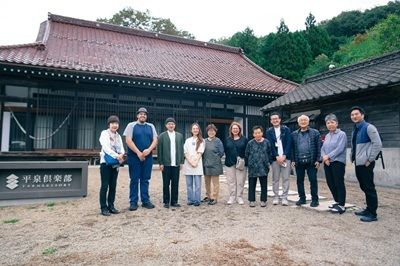Discovering a different side of Japan on a four-day journey through Tohoku. Here’s my Miyagi Experience.
When most travellers think of Japan, Tokyo, Kyoto, and Osaka usually top the list. But head north to Miyagi Prefecture in the Tohoku region, and you’ll find a quieter, richer Japan. One steeped in nature, tradition, and genuine hospitality.
As a Japan travel expert, I was fortunate to join a four-day tour hosted by the Miyagi Prefecture Government, and it opened my eyes to just how rewarding it can be to venture beyond the usual highlights. Here’s a look at what I experienced and why I recommend this region to my clients looking for something a little different.
Day 1: Traditions, Rice & Wetlands
 After a scenic two-hour bullet train ride from Tokyo to Kurihara City, we met our local host, Derek from The Hidden Japan and officials from Miyagi Tourism and began our journey with a hands-on look at local life.
After a scenic two-hour bullet train ride from Tokyo to Kurihara City, we met our local host, Derek from The Hidden Japan and officials from Miyagi Tourism and began our journey with a hands-on look at local life.
We started at Izunuma-nonsan Corp, where we learned about regional rice farming and took part in the joyful (and slightly strenuous!) tradition of mochi rice pounding. In Tome City, we stepped into a beautifully preserved 100-year-old farmhouse and made shimenawa, the sacred straw ropes hung at New Year. A heartfelt way to connect with Japan’s seasonal traditions.
Later, we visited the Izunuma-Uchinuma Wetlands, a Ramsar-listed site where over 100,000 migratory geese arrive each year from Siberia. As the sun dipped low and the skies filled with birds, I felt like I was standing inside a nature documentary.
We ended the day at Hiraizumi Club Japanese Inn, a peaceful countryside ryokan with delicious local cuisine and futon bedding that made for a restful night.
Day 2: Gorges, Golden Temples & Gourmet Surprise
 Our second day took us into neighbouring Iwate Prefecture, starting with a serene boat ride through Geibikei Gorge. The boatman guided us using only a pole and serenaded us on the return journey, a surprisingly emotional highlight.
Our second day took us into neighbouring Iwate Prefecture, starting with a serene boat ride through Geibikei Gorge. The boatman guided us using only a pole and serenaded us on the return journey, a surprisingly emotional highlight.
We then visited Chuson-ji Temple, a UNESCO World Heritage Site known for its gilded Golden Hall and fascinating history tied to the Fujiwara clan.
The evening was a true feast for the senses at the Kaze no Sawa Museum, a lovingly restored farmhouse-turned-art space and cafe. We were served an exquisite 14-course dinner by Chef Hitoshi Takayama and surprised with a live folk performance by the Yatsushika Dance group, which was filmed by local television!
Day 3: Mountains, Tea & a Lantern-Lit Onsen
 Day three was all about slowing down and soaking it all in. We travelled by retro-style Bonner bus to Mt. Kurikoma Visitor Park, where we learned about the area’s volcanic history and resilience after the 2008 inland earthquake.
Day three was all about slowing down and soaking it all in. We travelled by retro-style Bonner bus to Mt. Kurikoma Visitor Park, where we learned about the area’s volcanic history and resilience after the 2008 inland earthquake.
Lunch was a brave moment! Bear meat soba at Matagi Restaurant “Kariudo.” Surprisingly delicious, and a great talking point!
We then joined a quiet tea ceremony in a traditional kominka house, which reminded me why so many people fall in love with Japanese hospitality. It’s quiet, personal, and deeply intentional.
That night, we stayed at Lamp Yuhamaonsen Miura Hotel, an atmospheric hot spring inn lit entirely by lanterns and candles. No Wi-Fi. No phone signal. Just the sound of the river and the flicker of warm light. Bliss.
Day 4: Sake, Wagyu & Living History
 Our final day began with a gentle mountain walk led by the inn’s dog, P (short for Prince, we think).
Our final day began with a gentle mountain walk led by the inn’s dog, P (short for Prince, we think).
Then it was off to a sake brewery using pure spring water from nearby Kozo Fudo waterfall, followed by a tasting session that showcased the incredible depth of flavour in traditional brewing.
Lunch was a treat – grill-your-own Wagyu beef – rich and tender, served with locally grown vegetables.
Our final stop was Wakayanagi Jiori, a small textile business still using a 1915 Toyota-designed loom. Watching it in action felt like a step back in time, and a fitting way to end our journey, surrounded by heritage, passion, and pride.
Why I Recommend Miyagi to My Clients
Japan’s major cities will always be popular, and for good reason, but places like Miyagi offer something different. Here, travellers can connect with age-old traditions, meet local artisans and farmers, enjoy nature without the crowds, and slow down in a way that’s hard to do in Tokyo or Kyoto.
For clients who want to experience authentic, off-the-beaten-path Japan, I recommend adding Miyagi to the mix. It’s perfect for culturally curious travellers, nature lovers, and those who enjoy boutique stays, great food, and warm local hospitality.
Want to include this side of Japan in your itinerary? As a travel advisor who specialises in Japan holidays, I can help you create a custom trip that blends iconic highlights with hidden gems like Miyagi. I’ve been there, I know what to expect, and I can help you avoid the common pitfalls of DIY travel in rural Japan.
Let’s plan something special.


